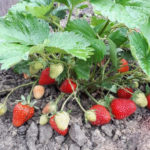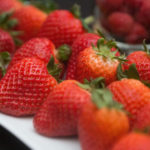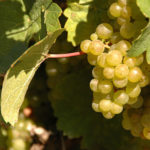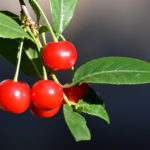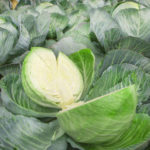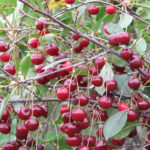Rkatsiteli grape variety
Rkatsiteli is an old white technical grape variety, originally from the Georgian region of Kakheti. It is traditionally believed that it has been growing in this area for many millennia, and during this time it was introduced to many neighboring regions. Until the anti-alcohol campaign of the 80s of the last century, it was considered almost the most widespread grape in the Soviet republics, but the massive uprooting of plantations significantly reduced the area under it, and the damage caused then has not been restored to this day. At home, a variety, along with another equally well-known Saperavi, forms the basis of local winemaking. Almost 60% of all Rkatsiteli grown in the world is in Georgia. Outside its borders, large plantations are located in Azerbaijan, Russia, Ukraine, Moldova, Romania and Bulgaria. Small experimental sites can be found overseas - in the USA and Australia.
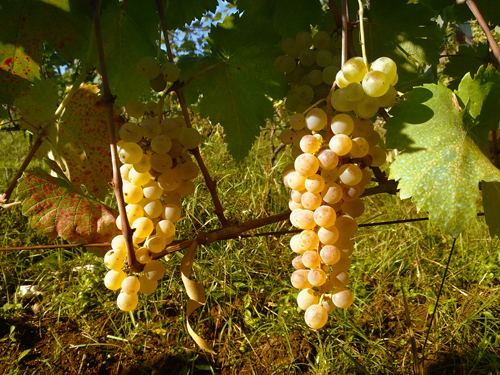
The reason for the popularity of this grape lies in the relatively high frost resistance of the vine, due to which the bushes in many regions do not require shelter for the winter, while other high-quality technical forms under the same conditions regularly freeze under the same conditions. This is especially important in the mountainous area of the Caucasus, with its rather harsh climate. In addition, the versatility of the resulting harvest is of no small importance, from which it is possible to make various types of wines - table, dessert, fortified, as well as used to obtain cognac distillates. There were many attempts to create varietal sparkling wines from our hero, but the natural high level of alcohol in the wine material did not allow achieving the desired quality of such drinks. Champagne made from it is almost always heavy.
In different regions of viticulture, you can hear numerous names-synonyms of the variety: Kukura, Mamali Rkatsiteli, Budashuri, Dedali Rkatsiteli, Korolek, Topolek, etc., which ultimately indicate this Georgian variety.
Agrobiological characteristics
Our hero belongs to the purebred representatives of the noble European-Asian grapes Vitis vinifera, and in ecological and geographical terms - to the group of varieties of the Black Sea basin. The bushes show high growth vigor and take on a pyramidal appearance due to powerful erect vines. Crowns of young shoots are grayish-white in appearance due to their intense pubescence. Young leaves are greenish-bronze, along their edges, when they appear, a pink border can be seen. The formed leaves are rich green, medium to large, rounded in shape, consisting of three or five lobes with a moderate dissection between them. The profile of the leaf blade is funnel-grooved. On the reverse side, there is a weak pubescence of the cobweb-bristly type. Upper lateral notches of medium or shallow depth, open in the form of a lyre or closed with an ovoid lumen. The lower notches are small, very diverse in shape - from open V-shaped ones to closed ones with almost no gap. The petiole notch is almost always open, it can be vaulted or lyre-shaped. The length of the petioles is comparable to the length of the main vein of the leaf; they are colored, like the axes of young shoots, in an intense wine-red color. The denticles along the perimeter of the leaf blade are triangular or saw-shaped, with one or both curved sides and sharp tops. The flowers are bisexual, which is why pollination is quite successful, and pea berries, as a rule, are not found.The tendency to shedding buds and ovaries in grapes was also not noticed. Ripening of the vine occurs quite fully - at 85-90% of the length of the shoots. At the same time, they are colored in a dark reddish-brown color with a more saturated pigmentation of the nodes.
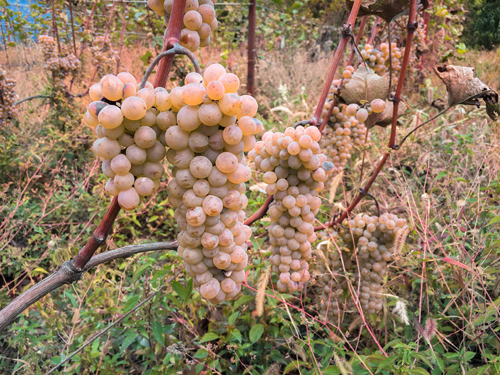
Rkatsiteli clusters reach sizes that are not bad for a technical variety, growing in length up to 14-17 cm, and in width up to 8-10 cm. Well-made brushes have a cylindrical or cylindrical-conical shape, often with a wing. They are moderately dense in structure. The comb usually does not exceed 5 cm, its color, like many vegetative parts of this variety, is anthocyanin. The berries are round or slightly oval, of medium size (15-18 mm in length and 14-16 mm in diameter). The standard weight of 100 grapes is 150-170 grams. Their color is very elegant and attractive - golden yellow with a bronze tan on the sunny side. A light, relatively intense waxy coating is visible on the surface. The pulp of the fruit is pleasant to the taste, very juicy, has its own specificity in the aftertaste and aroma. The total content of sugars in grape juice varies depending on the season and time of harvest in the range of 18-23 g / 100 ml, and under the most favorable conditions it can reach 25%. The titratable acidity is 8-10 g / l. The skin of the grapes is thin, but at the same time has a relative strength. The number of seeds does not exceed three. In general, the technological characteristics of the bunches are as follows: juice yield - about 80%, waste in the form of ridges - 3%, and in the form of skin, seeds and dense parts of pulp - 17%.
The use of the harvested crop can be very varied. In winemaking, where the lion's share of this grape is used, numerous types of high-quality drinks are prepared from it - young and matured, dry and dessert, table and fortified. Typical Rkatsiteli can be described as discreet and refreshing. In its bouquet, tones of green apple, quince or peach are most often found, although citrus and floral notes may be present. However, the lack of aromatic complexity can still be considered a certain disadvantage of this variety. Experienced winemakers correct this flaw with maceration, usually not typical for white wine technology. As a result of prolonged contact of the wort with the skin, the future drink acquires greater complexity and texture. Due to the slightly increased acidity, the wine manifests itself well when aged in oak barrels. After that, the aroma is enriched with soft vanilla tones and other spicy nuances.
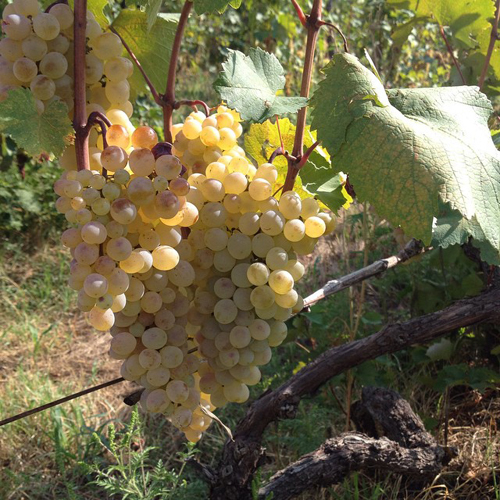
In addition to processing into alcoholic beverages, a very tasty, balanced juice is produced from the crop. In regions where the variety is widespread, this grape is also eaten fresh, and its tasting characteristics are very decent. In addition, the bunches have excellent keeping quality and can be stored in suitable conditions for several months.
In terms of ripening time, our hero belongs to relatively late-ripening varieties. The growing season lasts for 150-160 days, which, taking into account the late budding, leads to the onset of technical ripeness only at the beginning of October. The sum of active temperatures required for this period is 2900-3000 ° C, and means the possibility of cultivating Rkatsiteli only in the well-supplied warm south. However, another problem arises here - the very low drought resistance of plants, which requires the organization of irrigation of the vineyard in sultry regions in which there is a shortage of rain moisture.
The grape yield can be quite high, exceeding 100 kg / ha. However, this indicator, most often, is not constant. This is due, among other things, to the percentage of fruitful shoots fluctuating over the years from 20 to 70%.To neutralize this unpredictability, during spring pruning, the bushes are loaded with 50-60 eyes at once, and after the beginning of the growing season, they must carefully fragment the sterile and weak shoots, keeping 28-30 productive vines on the plant. Fruit arrows in the variety are left long, shortening them to 10-12 buds.
Rkatsiteli's resistance to fungal diseases and pests is different. To a certain extent, plants resist mildew and gray mold attacks. At the same time, susceptibility is noted to powdery mildew, as well as to some pests - grape leafworm and spider mite. The strategy of chemical protection of the vineyard must be built taking into account these features. Agrotechnical measures, such as lightening the fruit zone of the bushes, should not be neglected, which can significantly reduce the activity of many pathogens, and at the same time improve the condition of the resulting grape harvest.
